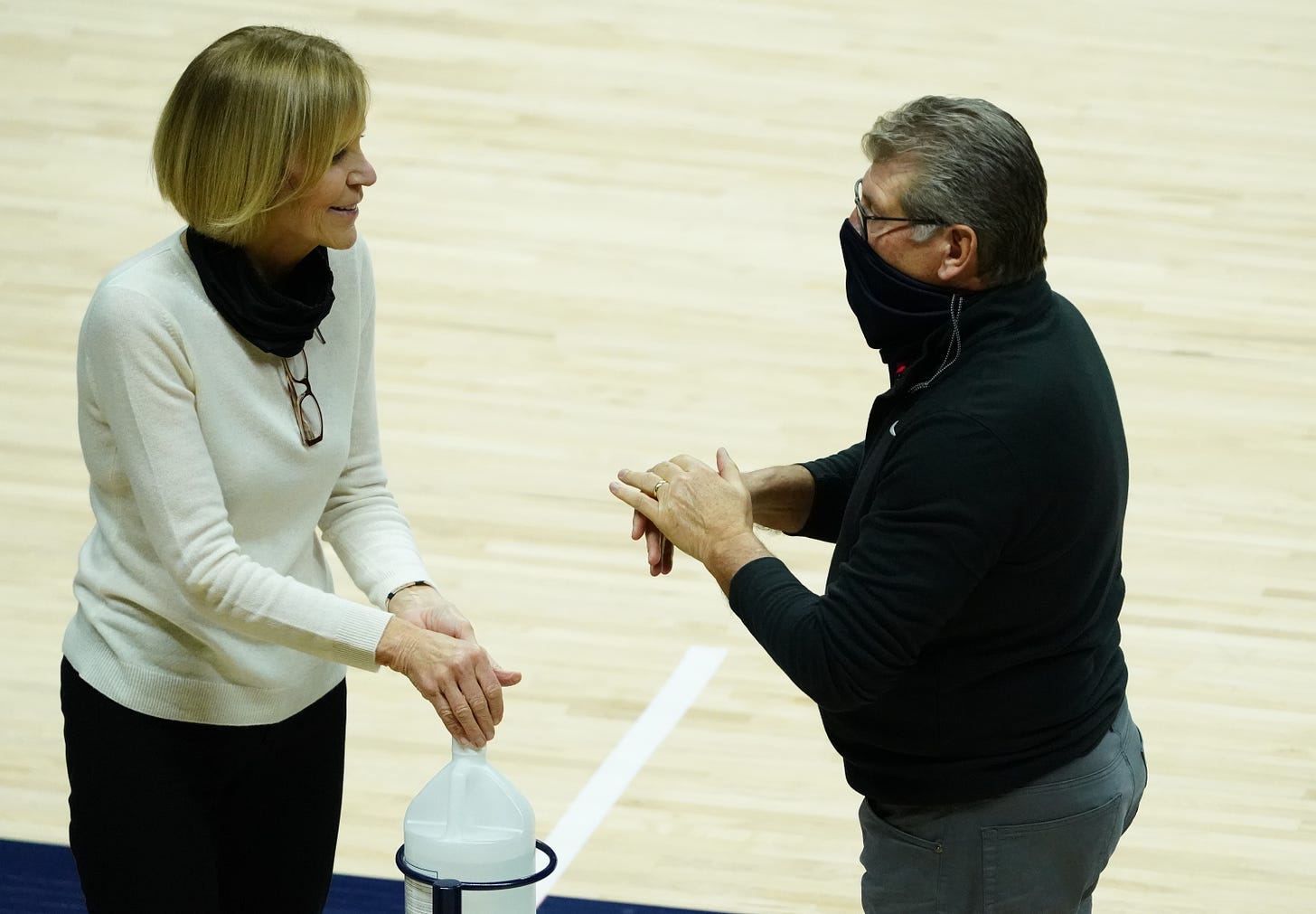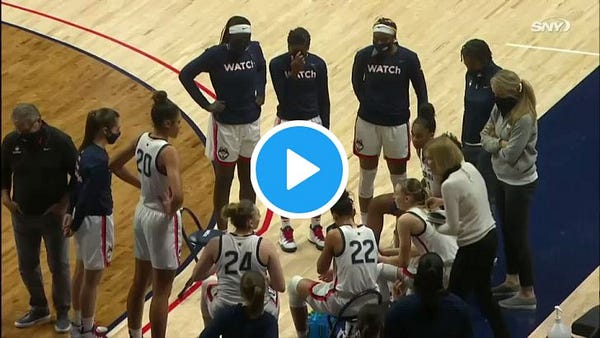Is this really the Big East's best plan for the season? Because it's not working
The conference needs to stop pretending like its current format is anything but a failure.
Welcome to the UConn WBB Weekly, a recap of everything that happened in the world of UConn women’s basketball over the past week from the team that runs The UConn Blog and Storrs Central.
Subscribe to get the Weekly in your inbox every Thursday and if you enjoy it, make sure to send it to all your fellow Husky diehards.
Top Links
From The UConn Blog and Storrs Central:
Dee Rowe was ‘the epitome of an ambassador’ for UConn basketball
UConn women’s basketball schedule tracker — Many, many more updates.
Providence coverage
Last week’s Weekly:
Elsewhere
After a 1-28 season last year, Morgan Valley’s Hartford women’s basketball team is coming along, in fits and starts (Hartford Courant)
Ranking the top 25 players in women’s college basketball, version 2.0 (ESPN) — Paige Bueckers comes in at No. 6, Christyn Williams at No. 20, and Olivia Nelson-Ododa at No. 21.
In the news
Bueckers earns familiar award
Another week, another Big East Freshman of the Week honor for Paige Bueckers. She won it for the fourth time this season after posting 23 points, five assists, and three steals against Providence on Saturday. Aubrey Griffin made the league’s weekly honor roll with her 18-point, nine-rebound effort as well.
Four future Huskies make Naismith cut
The Naismith Trophy announced its high school midseason watch list on Tuesday with four UConn commits on the list of 25 players: 2021 signees Azzi Fudd, Amari DeBerry, and Caroline Ducharme along with 2022 verbal commit Isuneh Brady.
Top 2022 prospect picks Stanford
Lauren Betts, the No. 1 player in the class of 2022, will be taking her talents to Stanford. On Wednesday the 6-foot-7 Colorado native announced her commitment to the Cardinal over UConn, Notre Dame, Oregon, UCLA, and South Carolina.
Is this really the Big East’s best plan?
In the span of just over five hours on Tuesday, two of UConn women’s basketball’s upcoming games were postponed because of COVID issues unrelated to the Huskies’ program.
First, Villanova paused team activities due to the virus, which knocked out UConn’s game on Saturday, Jan. 16. Later, the Huskies were forced to postpone their meeting against Seton Hall on Wednesday out of an abundance of caution after Providence — their most recent opponent — temporarily shut down.
Just four of UConn’s eight initially scheduled conference games have happened, while a couple more matchups were added after the league shifted some things around. If that doesn’t sound bad enough, only Butler, St. John’s, and Providence have played more conference games than UConn — and they’re only at seven.
In total, only 27 Big East women’s basketball games have actually occurred since league play began on Dec. 4 — six weeks ago. To complete the conference’s desired double-round robin schedule, 83 games need to be played between now and the first week of March — a span of seven weeks.
To expect conditions related to the virus to dramatically improve so that many games can happen in such a small timeframe would require either willful ignorance or a blatant disregard for teams’ health and safety from Big East headquarters. Something needs to change because as bad as things are now, they’ll only continue to get worse.
Over the next few weeks, the general student population will begin returning to campuses across the country. The entire college basketball season to this point has played on mostly empty campuses after most schools sent students home for winter break before Thanksgiving. So even with teams existing in pseudo-bubbles (or at least, that’s what the narrative was), COVID issues have persisted.
There’s also the larger issue of skyrocketing cases across the entire nation. As of 6 p.m. on Wednesday, Jan. 13, there have been nearly 200,000 newly confirmed cases of the virus and a staggering 1,954 deaths in the US over the last 24 hours. Not only is the pandemic completely out of control, but there are also no signs that it’ll peak anytime soon.
Some of this also falls on the NCAA, which should’ve stepped in long ago to pause the season and push the NCAA Tournament to May. If college basketball waited to restart in, say, early-to-mid March, that would give conditions a chance to improve — especially with vaccines already being distributed around the country.
Big East coaches met on Monday and will meet again Thursday to “discuss their options moving forward,” per Hearst CT’s Doug Bonjour. Realistically, those options are limited — it would take nothing short of a minor miracle for a full 110-game schedule to happen in the current format based on how things have played out so far.
So if the Big East remains determined to have every team play 20 conference games, the only reasonable path for that is with a bubble format — either small pods of 3-4 teams playing a handful of games against each other over the span of a week or so, or a true bubble like we saw the WNBA and NBA do this summer.
But if the conference (or the coaches, for that matter) insist on continuing to play games on campuses, it could look at what the America East is doing. In that conference, teams play on back-to-back days against the same opponent at the same venue. While the league is closer geographically, they’ve still played 32 of 90 games this season despite starting conference play two weeks after the Big East.
However, if the current format remains in place, then expectations need to be recalibrated significantly because a full 110-game schedule isn’t possible. Trying to squeeze in that many matchups — knowing full well teams will have shutdowns at various points — will create a condensed schedule that would undoubtedly be taxing on players’ bodies and could lead to more injuries.
There’s also an outside chance the Big East says they’ve seen enough and cancels the entire season — following the lead of the Ivy League, Duke and SMU — but I could also win the lottery tomorrow. It’s possible, but we know it won’t happen.
Regardless of the decision made, the Big East needs to adjust its goals. As always, the first priority should be keeping players, staff, and everyone else involved safe and healthy during the pandemic. However, it also needs to make sure that it doesn’t overload teams’ schedules for the reasons mentioned above.
With those two things in mind, the conference should focus on getting each team to the 13-game threshold — the minimum number required to be eligible for the NCAA Tournament — especially teams like UConn, DePaul, Marquette, and Villanova, who have the best odds of making the field. If each school can somehow complete a 20-game double round-robin schedule, that’s just a bonus.
But ultimately, something needs to change. The Big East tried to play a season without making any substantial changes to account for the pandemic and is paying for that decision with constant postponements and schedule adjustments. The conference’s plan hasn’t worked and there’s no reason to believe it’ll get better.
The Big East has the opportunity to be a leader. It can be the first major conference to not only acknowledge its failures but also take a step in a new direction — whether that be a different format or a change in expectations.
We’ve reached a critical mass, though. The season is near its halfway point and time is running out for a solution. The Big East’s next move is crucial. Not only will it decide what the rest of the year looks like, but its action (or lack thereof) will show exactly where the league’s priorities lie.
Best of social media
Geno had enough against Providence:
These two will be a fun combo for the next four years:


Jay Williams with nothing but facts:

Quotables
Auriemma had a pair of fascinating, retrospective answers after the Providence game.
On losing games: “I’ve coached a lot of kids that get pissed off when we lose. I don’t know if that’s the way it is today in the world. But all these years that I’ve coached in Connecticut, when we lose a game, guys are really pissed and it doesn’t take much for me to get them ready to go the next game. So there’s this mindset at Connecticut where, when we lose a game, everyone takes it personally. There’s no ‘Well, you know, it’s just one of those things, we’ll get the next one. Don’t worry about it.’ No. For all those years, going back, however long you want to go back, losing — whether we lost four games or five games or one game those years — losing the game at Connecticut was life-changing for a lot of these kids.”
On when the program started to receive the media attention it has today: “The very first [press conference] we ever did was probably in 1991, but other than the NCAA Tournament where you’re forced to do it at the regionals, I don’t remember ever doing any. Never. Never. I don’t remember doing it. No, certainly not after games like this. It was ‘95 (the 1995 championship season). ‘95 changed everything...that Tennessee game on Martin Luther King Day was probably the event. That was the single moment in Connecticut basketball history that probably pushed that snowball down a hill for the very first time.”
Scoreboard
Thursday, Jan. 7
No. 2 Louisville 71, Virginia Tech 67
Tennessee 88, No. 13 Arkansas 73
Providence 62, Butler 50
Saturday, Jan. 9
St. John’s 64, Butler 56
Sunday, Jan. 10
Washington State 71, No. 7 Arizona 69
Monday, Jan. 11
Seton Hall 79, Butler 64
Wednesday, Jan. 13
No. 19 DePaul 101, St. John’s 84
Butler 58, Georgetown 40
AP Poll
1. Stanford (—)
2. Louisville (—)
3. NC State (—)
4. UConn (-1)
5. South Carolina (—)
Notables:
After being tied with NC State last week, UConn dropped back to No. 4; the Wolfpack received two more points than the Huskies.
DePaul moved up one spot to No. 19.
Tennessee entered the top 25 at No. 23.






